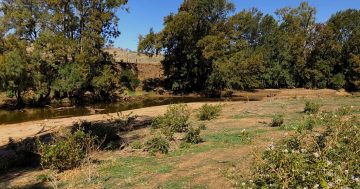
Council Supervisor Paul Martin and farmer Guy McPhee looking for weeds at Runnymede. Photo: Supplied.
Generous deliveries of donated hay and other stock feed made during the drought and fires could carry a bitter legacy for South Coast farmers, who are being urged to check their land for possible outbreaks of noxious weeds.
Stockfeed donated to coastal farmers may have come from far distant regions with established weed populations that have been unknown on the coast to date.
And unfortunately, that lack of familiarity with accidentally imported species may also make these weeds harder to identify for local landholders.
“If people think fireweed is bad, try getting tropical soda apple or parthenium weed under control. Plants like those two can destroy local agriculture and may not be familiar to our local farmers, or look similar to existing weeds and fly under the radar,” said Eurobodalla Shire Council Invasive Species Supervisor Paul Martin.
Farmers and landholders can request a visit from the Council’s Invasive Species team, as they visit fire-affected properties in the coming months to identify and flag weeds of agricultural concern.
Mr Martin said property visits were already underway and would continue until June, focussing on properties west of the Princes Highway in fire-affected areas; Runnyford, Currowan and Buckenbowra, and the Deua and Tuross catchments, including Belowra and Nerrigundah.
“We’ve received reports that stock owners received hay from as far afield as Western Australia and Tasmania,” Mr Martin said. “With only limited traceability for most stockfeed donations, we can’t verify their weed status. That could lead to an increased risk of agricultural weed incursion.”
“We’re here to help anyone who’s seeing different and unusual plants popping up, especially after the fires which laid areas bare for infestation” he said.
The invasive species could include plants such as tropical soda apple which can take over a paddock within six months and is a host for diseases and pests which affect cultivated crops, and is poisonous to humans, or parthenium weed which is poisonous to both humans and animals.
The latter is regarded as one of the worst weeds in Australia because of its invasiveness, potential for spread, and economic and environmental impacts. Its impact on the Queensland pastoral industry is estimated at more than $22 million a year in reduced production and increased management costs and the weed is also a known major allergen for humans, causing dermatitis, hay fever and asthma.
All local property visits will be conducted in line with COVID-10 best practice and staff will be driving separate vehicles, and observe social distancing requirements.
To organise a visit or request plant identification, contact Paul Martin on 4474 1269 or [email protected].








